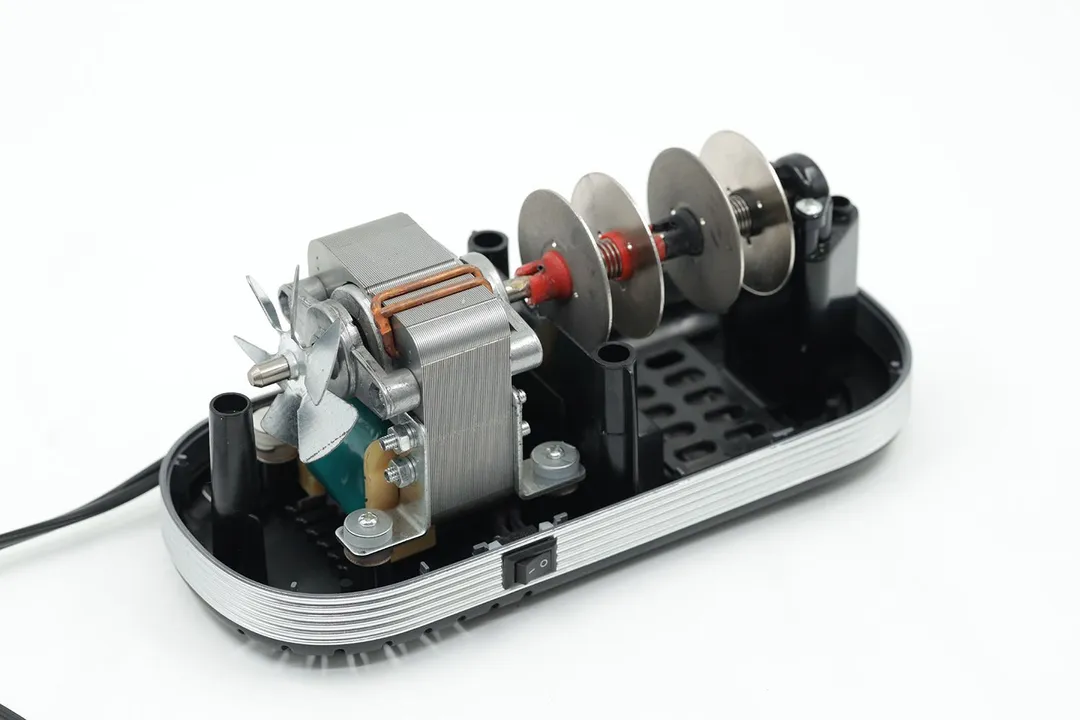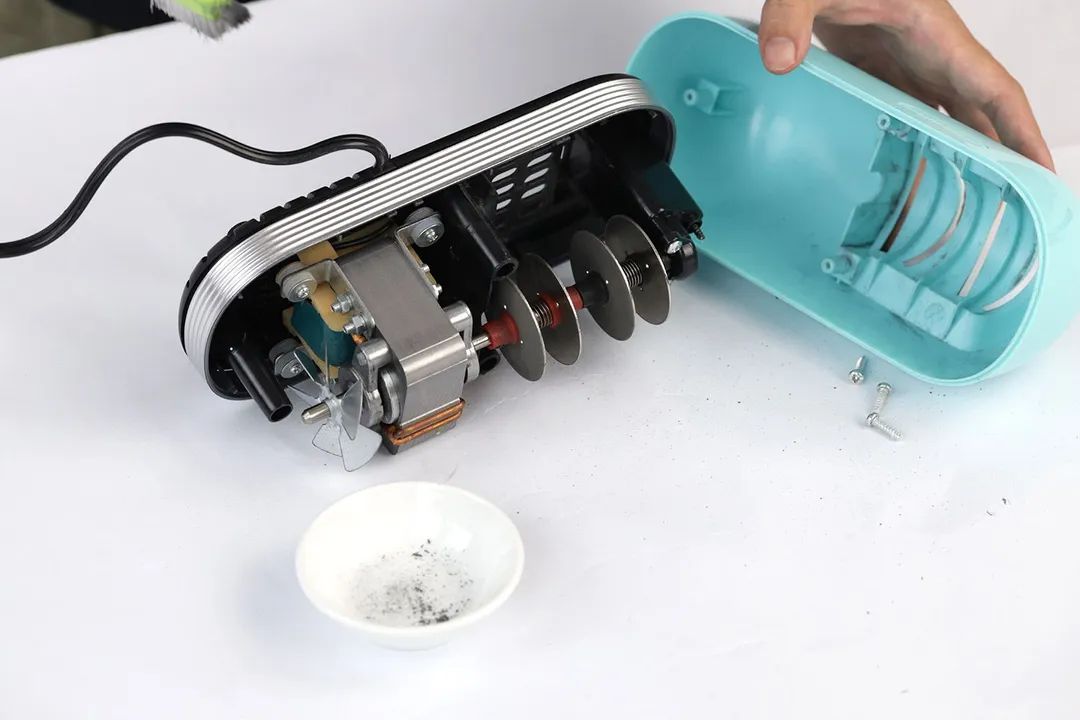Our recommendations are made independently through Research & Testing. We may receive commissions from purchases made via our links.
How We Test and Rate Electric Knife Sharpeners v1.0
Our test procedure for electric knife sharpeners and how we rate them for performance, ease of use, and design.
Each type of knife sharpeners caters to different needs. While manual pull-through sharpeners sacrifice sharpness and edge retention for convenience and whetstones do the opposite, electric knife sharpeners are expected to offer the best of both worlds.
As such, they come at a higher price range than most manual devices. To help you decide which one might be worth your investment, we bought a bunch of electric knife sharpeners and put them all through the same series of tests.
Here are the three overarching parameters we use to test and rate all electric sharpeners.
Performance: 40% of the total rating
Design: 30% of the total rating
Ease of Use: 30% of the total rating
Scores range between zero and 10 — a zero means the sharpener completely lacks the feature or fails the test, and a 10 translates to a perfect feature or performance.
Performance
Score weight: 40%
Performance is the most important factor when buying a sharpener, but it’s hard to tell how well a machine works by looking at the design or the price alone. That’s why we test all electric sharpeners meticulously so you know what to expect before you buy.
Unlike with manual sharpeners, electric devices can almost always bring your blades back to a serviceable level. As such, the performance of an electric sharpener is determined by its speed, continuous working time, the amount of erosion of both the abrasives and the blade, and the quality of the knife edge after sharpening.
Below is a brief explanation of the performance parameters and their score weights. Click on the headings to get a detailed description of each test procedure.
- Speed (30%): We test how long it takes for a sharpener to bring a blunted knife to the beef-tendon-cutting level.
- Edge Quality (40%): We check to see if the knife edge is straight, smooth, even, and has an appropriate bevel height.
- Continuous Operating Time (20%): We collect and assess the amount of material removed from the knife after a sharpening session.
- Material Retention (10%): We test to see if an electric sharpener can deal with 4 - 5 blunted kitchen knives in succession.
Design
Score weight: 30%

The design of an electric sharpening machine affects not only its durability, but also its functionality. We test and disassemble each sharpener to take a thorough look before rating their build quality. We also rate them on their abilities to accommodate different edge angles, edge types, and knife lengths.
Build Quality (55%)
Machines made with better materials and built with tighter tolerances can dissipate heat better, produce less noise, and are more stable during sharpening. They can also withstand more abuse.
The scoring factors for build quality include material quality and fit and finish. We inspect the sharpeners — both on the inside and outside — and check for unusual sounds, sights, or smells during use.
Angle Adjustability (20%)
A sharpener that can accommodate more grind angles gives you more options when sharpening. It allows you to preserve the original edge angles on different types of knives or change your cutting style as desired.
We score the angle adjustability on a scale of 1 to 10: every grind angle accommodated gains it one extra point.
Knife Size Accomodation (15%)
We run several common kitchen knives through the sharpener to see if it can handle various lengths and thicknesses. The knives include an 8-inch chef’s knife, a 7.5-inch cleaver, a 6-inch utility knife, and a 5-inch peeling knife.
Edge Type Accomodation (10%)
Some sharpeners have fine abrasives that allow them to hone the edge of a serrated knife or work on hooks. Such machines gain extra points for being so versatile.
Ease of Use
Score weight: 30%

Most people who buy an electric sharpener expect it to deliver excellent sharpness with very little effort on the operator’s part. The machines we see on the market all seem to accommodate that: plug the machine in, press the power button, insert the knife into the slot and pull it through.
However, the little details here and there make a difference in how challenging they are to work with.
Setup (20%)
Easy setup saves time and allows you to focus on sharpening your knives.
The size and weight of a sharpener are factors when moving the sharpener around or storing it in a drawer. Luckily, the rest of the setup is usually very simple, though a select few machines take some learning.
All of these are taken into account as we score the ease of setup for each device.
Insertion (20%)
Ideally, the machine starts sharpening as soon as you insert your blade into the abrasive slot. However, the differences in angle guides and abrasives can make or break this experience.
A sharpener gains a higher score if its slot openings are easily accessible and if it’s effortless to pull the blade through.
Stability (20%)
Unlike manual sharpeners, most electric sharpeners are heavy enough that they’ll stay in place during sharpening. As such, for these machines, weight and base design don’t affect stability as much as the design of the abrasives.
Machines with sturdy and stable abrasives are given higher scores in this category. Scores suffer if the sharpener vibrates violently, pushes the blade out, or stalls easily.
Maintenance (10%)
Most electric sharpeners don’t require maintenance other than basic cleaning. However, their parts may degrade and the abrasives become less effective over time.
As such, we assess the ease of maintenance using two factors: the availability of replacement parts and the unit’s warranty.
Some machines include replacement parts in the package — we grant these the highest scores. Some others not only come without spare parts, but we couldn’t even find them anywhere on the market. Those get 0 points for maintenance. The scores in between reflect how easy it is to find replacement parts online.
Most brands offer a 1-year warranty for their electric sharpeners; we view that as a baseline policy worth 5 points. A shorter time translates to 0 points. Meanwhile, a 2-year warranty would gain 8 points, 3 years is worth 9 points, and 4 years or more gets a perfect 10.
Safety (30%)
Sharpening involves the grinding of the blade against abrasive materials. This process happens at a higher speed on electric sharpeners than on any manual sharpening device, and produces a lot of fine dust, loud noise, and heat.
We rate the safety level of each device by assessing the following factors:
1. Noise Level
Electric sharpeners are loud, but is that noise just a minor inconvenience or can it impact your health? We use a decibel (dB) meter to measure the noise each electric sharpener makes during sharpening and note the highest decibel values registered.
According to the CDC, damage to hearing may occur after about 2 hours of exposure to 80 dB. A typical sharpening session with an electric sharpener lasts less than a quarter this duration, so if the noise is lower than 80 dB, it’s not likely to cause health consequences. As such, any electric sharpener that’s quieter than 80 dB gets 10 points.
Every decibel louder translates to a 0.2-point deduction. Because hearing loss can occur in less than 5 minutes at 105 dB, any sharpener that reaches that point or beyond would receive 0 points.
2. Heat
All electric sharpeners emit heat, but the amount varies greatly.
Even though most electric sharpeners don’t need you to stabilize them with your hand, you don’t want a machine that gets so hot it can burn you. Plus, nobody wants to wait half an hour for their appliance to cool before tucking it back in the drawer.
Using a thermometer, we monitor each sharpener’s temperature during the Maximum Working Time test and record its highest values. Various studies suggest that humans start to feel pain when exposed to surface temperatures of 43 - 44°C (109.4°F); at 50°C (122°F), it takes only 4 minutes to cause injury.
Therefore, machines that remain cooler than 43°C get 10 points, and those that exceed 55°C receive 0 points. The detailed point breakdown is listed in Table 2 below.
3. Dust
During sharpening, the abrasives remove some material from the knife to create a sharp edge. Small bits of abrasive material also separate from the device in the process. This produces metal and mineral dust which quickly flies off the abrasive wheels and into the air.
The amount of dust and how far it can spread depends on the sharpener’s design. Some machines, such as the Chef’s Choice Trizor XV, have angle guides that cover parts of the abrasives and trap most of the dust inside. On some others, such as the Work Sharp Ken Onion, sharpening happens in the open, so any dust is free to fly up into the air.
Metal dust can cause various health problems if it gets into your eyes, digestive tract, or respiratory system. It’s expected — and sometimes stated in the user’s manual — that you wear dust masks and safety glasses when using an electric sharpener.
Regardless, it’s always better if your sharpener has an effective built-in dust protection mechanism. We give the highest dust scores to those. Electric sharpeners that allow dust to flare up receive the lowest scores.
Test Developers
Anh Ngo is a writer with 9 years experience at different media outlets, covering from public news and events to product testing and analysis. At HealthyKitchen101, she works across different departments, communicating closely with its network of writers, editors, and health, tech, and search engine experts to provide a meaningful and pleasant reading experience for visitors.
Lap is Head of the Research, Testing, and Review Team (RTR Team) at HealthyKitchen101.com, where he directs and supervises the testing of kitchen gadgets and appliances.
Nguyen Ntk is a graphic designer, photographer, and videographer whose philosophy centers around respecting and celebrating the beauty of reality. Through his lenses, Nguyen strives to capture the true essence of objects and events, showcasing and highlighting authentic features without distortion or exaggeration.



